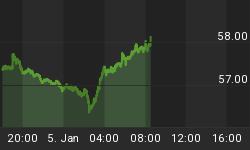I have often in the past referred to the CBOE Volatility (VIX) Index, also known as Wall Street's "fear index". This is a measure of the implied volatility of S&P 500 index options - a high value corresponds to a more volatile market and therefore more costly options.
The VIX Index is an excellent contrary indicator, moving in the opposite direction to stocks, and worth keeping an eye on. The Index peaked at 80.9 in November 2008 and has since declined to a low of 15.6 beginning March before edging up a bit to 16.4. To add some longer-term perspective, the relatively calm four-year period prior to the start of the credit crisis was characterized by a range between 10 and 20.
The graph below shows the neat historical inverse relationship between the S&P 500 Index (black line) and the VIX (red).

Source: StockCharts.com
I am of the opinion that the nascent cyclical bull market is looking tired, on top of the fact that stocks over over-loved, overbought and overvalued. But let's also get a second opinion on the matter and who better than from David Fuller (Fullermoney) from across the pond. He said: "Over the last fortnight I have repeatedly mentioned that the excellent stock market rally over the previous nine to ten weeks was becoming increasingly overextended relative to the mean for numerous trends. Last Friday and also this Monday, we saw a number of downward dynamics for many important stock market indices, such as the Dow Jones Industrial Index, the Shanghai Composite Index, the Switzerland SMI Index and the Australia AS&P ASX200 Index. Where they occurred, they interrupted short-term upward trends, indicating that a reaction and consolidation had commenced. I have also mentioned that this could turn into a mean reversion correction for some stock markets.
"I do not think we are witnessing the onset of new or renewed bear markets. However, there have been some blows to investor confidence recently - mainly deteriorating sovereign debt problems, China's monetary tightening to check property speculation, and the SEC's case against Goldman Sachs. These events have checked upward momentum for most stock markets at a time when they were technically overstretched in the short term. Lastly, debt concerns prevented southern European stock markets from participating in the February to mid-April uptrend extension rallies seen elsewhere and laggards such as Greece, Portugal and Spain are trading below their moving averages."
Back to the VIX: One way of hedging an equity portfolio is to bet on increased volatility that is bound to happen with any stock market correction. One can do this by buying either the iPath S&P 500 VIX Short-term Futures ETN (VXX) or iPath S&P 500 VIX Mid-Term Futures ETN (VXZ). VXX invests in VIX futures contracts ending within the next two months, whereas VXZ is made up of VIX futures contracts running for four to seven months. A word of warning, though: these products generally represent an excellent way of hedging against stock market declines, but may not always fully track the VIX as a result of investing in futures that are also affected by other risk factors.
The graph below shows the VIX Index (red line) together with both VXX (green) and VXZ (blue).

Source: StockCharts.com
Did you enjoy this post? If so, click here to subscribe to updates to Investment Postcards from Cape Town by e-mail.















